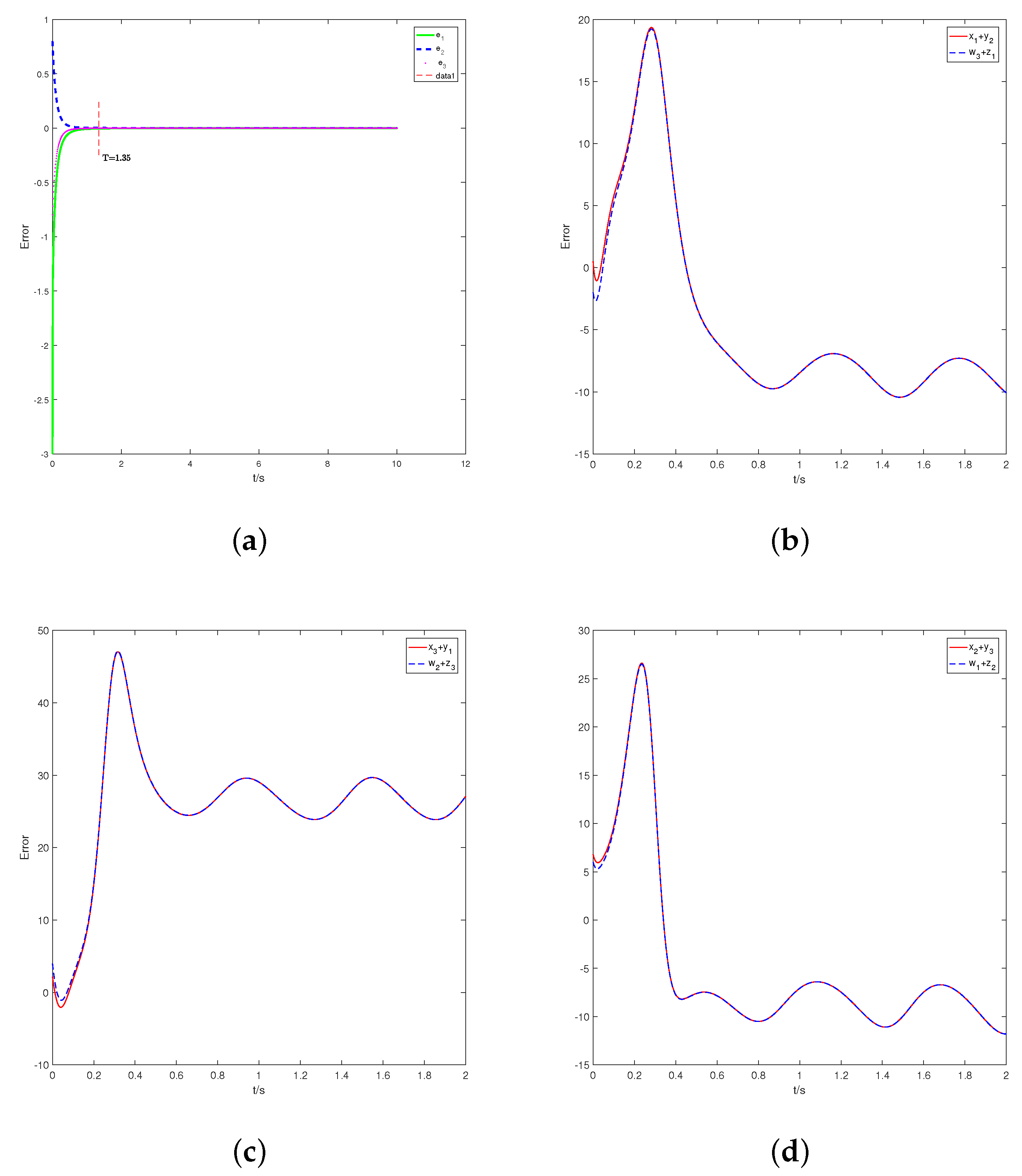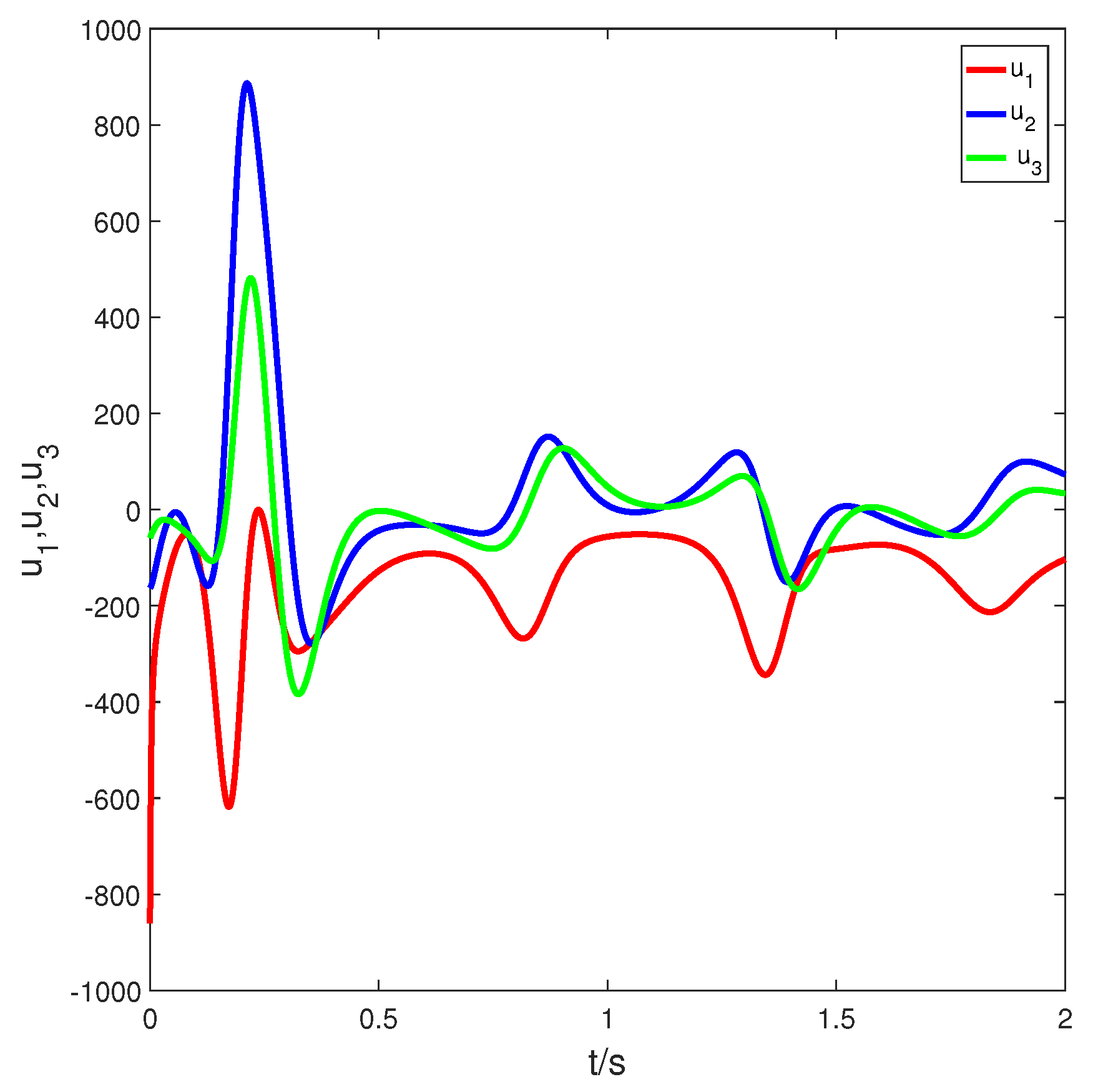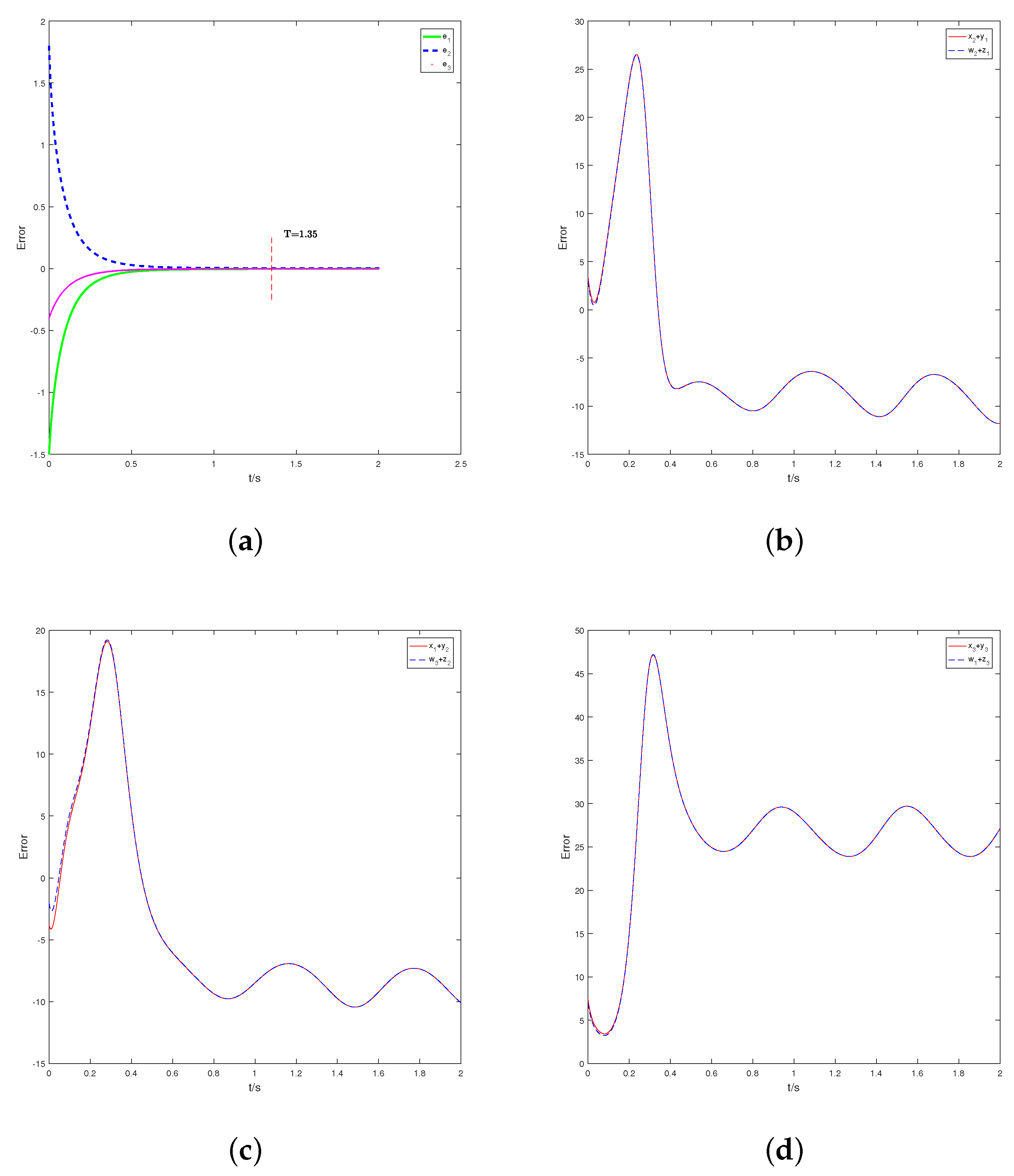Fixed-Time Multi-Switch Combined–Combined Synchronization of Fractional-Order Chaotic Systems with Uncertainties and External Disturbances
Abstract
1. Introduction
- (1)
- By designing a suitable sliding mode surface and controller, the fixed-time synchronization of a fractional-order chaotic system is realized, ensuring that the system can synchronize in finite time and is not restricted by the initial value condition.
- (2)
- Multi-switch synchronization and fixed-time synchronization are combined for the first time to realize the fixed-time multi-switch synchronization of a fractional-order chaotic system.
- (3)
- Because of the multiplexing, the combinations of synchronizations become more numerous, which makes it difficult for an intruder to predict the combination of synchronizations that will occur, so this method has higher security in secure communication applications.
2. Preliminaries
3. System and Problem Description
4. Numerical Simulation
4.1. Switch 1
4.2. Switch 2
5. Conclusions
Author Contributions
Funding
Institutional Review Board Statement
Informed Consent Statement
Data Availability Statement
Acknowledgments
Conflicts of Interest
Abbreviations
| FTMSCCS | Fixed time multi-switch combination–combination synchronization |
| MSCCS | Multi-switching combination–combination synchronization |
References
- Lorentz, E.N. Deterministic non-periodic flows. J. Atmos. Sci. 1963, 20, 130–141. [Google Scholar] [CrossRef]
- Ueta, T.; Chen, G. Bifurcation analysis of Chen’s equation. Int. J. Bifurc. Chaos Appl. Sci. Eng. 2000, 10, 1917. [Google Scholar] [CrossRef]
- Jing, Z.J.; Yu, C.; Chen, G.R. Complex dynamics in a permanent-magnet synchronous motor model. Chaos Solitons Fractals 2004, 22, 831–848. [Google Scholar] [CrossRef]
- Pecora, L.M.; Carroll, T.L. Synchronization in chaotic systems. Phys. Rev. Lett. 1990, 64, 821–824. [Google Scholar] [CrossRef] [PubMed]
- Li, K.Z.; Zhao, M.C.; Fu, X.C. Projective synchronization of driving–response systems and its application to secure communication. IEEE Trans. Circuits Syst. Regul. Pap. 2009, 56, 2280–2291. [Google Scholar]
- Wu, X.J.; Lu, Y. Generalized projective synchronization of the fractional-order Chen hyperchaotic system. Nonlinear Dyn. 2009, 57, 25–35. [Google Scholar] [CrossRef]
- Zhu, Z.Y.; Zhao, Z.S.; Zhang, J.; Wang, R.K.; Li, Z.Q. Adaptive fuzzy control design for synchronization of chaotic time-delay system. Inf. Sci. 2020, 535, 225–241. [Google Scholar] [CrossRef]
- Liu, H.; Li, S.G.; Wang, H.X.; Li, G.J. Adaptive fuzzy synchronization for a class of fractional-order neural networks. Chin. Phys. B 2017, 26, 262–271. [Google Scholar] [CrossRef]
- Hu, M.F.; Xu, Z.Y. Adaptive feedback controller for projective synchronization. Nonlinear Anal. Real World Appl. 2008, 9, 1253–1260. [Google Scholar] [CrossRef]
- Pemen, A.J.M.; Heesch, E.J.M.V.; Zhen, L. Synchronous pulse systems. IEEE Trans. Plasma Sci. 2012, 40, 1198–1204. [Google Scholar] [CrossRef]
- Qiao, Z.W.; Shi, T.N.; Wang, Y.D.; Yan, Y.; Xia, C.L.; He, X.N. New sliding-mode observer for position sensorless control of permanent-magnet synchronous motor. IEEE Trans. Ind. Electron. 2013, 60, 710–719. [Google Scholar] [CrossRef]
- Cao, Y.; Nikan, O.; Avazzadeh, Z. A localized meshless technique for solving 2D nonlinear integro-differential equation with multi-term kernels. Appl. Numer. Math. 2023, 183, 140–156. [Google Scholar] [CrossRef]
- Wang, Q.; Qi, D.L. Synchronization for fractional order chaotic systems with uncertain parameters. Int. J. Control. Autom. Syst. 2016, 14, 211–216. [Google Scholar] [CrossRef]
- Huang, C.D.; Cao, J.D. Active control strategy for synchronization and anti-synchronization of a fractional chaotic financial system. Phys. Stat. Mech. Its Appl. 2017, 473, 262–275. [Google Scholar] [CrossRef]
- Mohammadzadeh, A.; Ghaemi, S. Robust synchronization of uncertain fractional-order chaotic systems with time-varying delay. Nonlinear Dyn. 2018, 93, 1809–1821. [Google Scholar] [CrossRef]
- Zhang, X.; Wu, R.C. Modified projective synchronization of fractional-order chaotic systems with different dimensions. Acta Math. Appl. Sin. Engl. Ser. 2020, 36, 527–538. [Google Scholar] [CrossRef]
- Haris, M.; Shafiq, M.; Ibrahim, A.; Misiran, M. Nonlinear feedback controller for the synchronization of hyper (Chaotic) systems with known parameters. J. Math. Comput. Sci. 2020, 23, 124–135. [Google Scholar] [CrossRef]
- Ababneh, O.Y. Adaptive synchronization and anti-synchronization of fractional order chaotic optical systems with uncertain parameters. J. Math. Comput. Sci. 2021, 23, 302–314. [Google Scholar] [CrossRef]
- Li, X.G.; Rao, R.F.; Zhong, S.M.; Yang, X.S.; Li, H.; Zhang, Y.L. Impulsive control and synchronization for fractional-order hyper-chaotic financial system. Mathematics 2022, 10, 2737. [Google Scholar] [CrossRef]
- Polyakov, A. Nonlinear feedback design for fixed-time stabilization of linear control systems. IEEE Trans. Autom. Control 2012, 57, 2106–2110. [Google Scholar] [CrossRef]
- Ni, J.K.; Liu, L.; Liu, C.X.; Hu, X.Y. Fractional order fixed-time nonsingular terminal sliding mode synchronization and control of fractional order chaotic systems. Nonlinear Dyn. 2017, 89, 2065–2083. [Google Scholar] [CrossRef]
- Shirkavand, M.; Pourgholi, M. Robust fixed-time synchronization of fractional order chaotic using free chattering nonsingular adaptive fractional sliding mode controller design. Chaos Solitons Fractals 2018, 113, 135–147. [Google Scholar] [CrossRef]
- Yao, Q.J. Synchronization of second-order chaotic systems with uncertainties and disturbances using fixed-time adaptive sliding mode control. Chaos Solitons Fractals 2021, 142, 110372. [Google Scholar] [CrossRef]
- Shirkavand, M.; Pourgholi, M.; Yazdizadeh, A. Robust global fixed-time synchronization of different dimensions fractional-order chaotic systems. Chaos Solitons Fractals 2022, 154, 11616. [Google Scholar] [CrossRef]
- Almatroud, A.O.; Ababneh, O.; Al-Sawalha, M.M. Modify adaptive combined synchronization of fractional order chaotic systems with fully unknown parameters. J. Math. Comput. Sci. 2020, 21, 99–112. [Google Scholar] [CrossRef]
- Zhou, L.L.; Wang, C.H.; Lin, Y.; He, H.Z. Combinatorial synchronization of complex multiple networks with unknown parameters. Nonlinear Dyn. 2015, 79, 307–324. [Google Scholar] [CrossRef]
- Kaviarasan, B.; Kwon, O.M.; Park, M.J.; Sakthivel, R. Composite synchronization control for delayed coupling complex dynamical networks via a disturbance observer-based method. Nonlinear Dyn. 2020, 99, 1601–1619. [Google Scholar] [CrossRef]
- Zhang, B.; Deng, F.Q. Double-compound synchronization of six memristor-based Lorenz systems. Nonlinear Dyn. 2014, 77, 1519–1530. [Google Scholar] [CrossRef]
- Ucar, A.; Lonngren, K.E.; Bai, E.W. Multi-switching synchronization of chaotic systems with active controllers. Chaos Solitons Fractals 2008, 38, 254–262. [Google Scholar] [CrossRef]
- Wang, X.Y.; Sun, P. Multi-switching synchronization of chaotic system with adaptive controllers and unknown parameters. Nonlinear Dyn. 2011, 63, 599–609. [Google Scholar] [CrossRef]
- Vincent, U.E.; Saseyi, A.O.; McClintock, P.V.E. Multi-switching combination synchronization of chaotic systems. Nonlinear Dyn. 2015, 80, 845–854. [Google Scholar] [CrossRef]
- Zheng, S. Multi-switching combination synchronization of three different chaotic systems via nonlinear control. Opt. Z. Fur-Licht-Und Elektron. J. Light-Electronoptic 2016, 127, 10247–10258. [Google Scholar] [CrossRef]
- Song, S.; Song, X.N.; Pathak, N.; Balsera, I.T. Multi-switching adaptive synchronization of two fractional-order chaotic systems with different structure and different order. Int. J. Control. Autom. Syst. 2017, 15, 1524–1535. [Google Scholar] [CrossRef]
- Khan, A.; Bhat, A.A. Multi-switching combination–combination synchronization of non-identical fractional-order chaotic systems. Math. Methods Appl. Sci. 2017, 40, 5654–5667. [Google Scholar] [CrossRef]
- Zhang, H.; Wang, X.Y.; Zhang, J.; Yan, P.F. Multi-switching combination synchronization of spatiotemporal coupled chaotic systems with complexities. Int. J. Mod. Phys. Comput. Phys. Phys. Comput. 2019, 30, 1950067. [Google Scholar] [CrossRef]
- Shafiq, M.; Ahmad, I. Multi-Switching combination anti-synchronization of unknown hyperchaotic systems. Arab. J. Sci. Eng. 2019, 44, 7335–7350. [Google Scholar] [CrossRef]
- Muhammad, S.; Israr, A.; Ambusaidi, M.A.; Bashir, N. Robust adaptive multi-switching synchronization of multiple different orders unknown chaotic systems. J. Syst. Sci. Complex. 2020, 33, 1330–1359. [Google Scholar] [CrossRef]
- Pan, W.Q.; Li, T.Z.; Sajid, M.; Ali, S.; Pu, L.P. Parameter identification and the finite-time combination–combination synchronization of fractional-order chaotic systems with different structures under multiple stochastic disturbances. Mathematics 2022, 10, 712. [Google Scholar] [CrossRef]
- Podlubny, I. Fractional Differential Equations; Elsevier Science and Technology: Amsterdam, The Netherlands, 1998. [Google Scholar]
- Aguila-Camacho, N.; Duarte-Mermoud, M.A.; Gallegos, J.A. Lyapunov functions for fractional order systems. Commun. Nonlinear Sci. Numer. Simul. 2014, 19, 2951–2957. [Google Scholar] [CrossRef]
- Li, Y.; Chen, Y.Q.; Podlubny, I. Stability of fractional-order nonlinear dynamic systems: Lyapunov direct method and generalized Mittag-Leffler stability. Comput. Math. Appl. 2009, 59, 1810–1821. [Google Scholar] [CrossRef]
- Zuo, Z.; Tie, L. Distributed robust finite-time nonlinear consensus protocols for multi-agent systems. Int. J. Syst. Sci. 2016, 47, 1366–1375. [Google Scholar] [CrossRef]




Disclaimer/Publisher’s Note: The statements, opinions and data contained in all publications are solely those of the individual author(s) and contributor(s) and not of MDPI and/or the editor(s). MDPI and/or the editor(s) disclaim responsibility for any injury to people or property resulting from any ideas, methods, instructions or products referred to in the content. |
© 2023 by the authors. Licensee MDPI, Basel, Switzerland. This article is an open access article distributed under the terms and conditions of the Creative Commons Attribution (CC BY) license (https://creativecommons.org/licenses/by/4.0/).
Share and Cite
Liu, D.; Li, T.; He, X. Fixed-Time Multi-Switch Combined–Combined Synchronization of Fractional-Order Chaotic Systems with Uncertainties and External Disturbances. Fractal Fract. 2023, 7, 281. https://doi.org/10.3390/fractalfract7040281
Liu D, Li T, He X. Fixed-Time Multi-Switch Combined–Combined Synchronization of Fractional-Order Chaotic Systems with Uncertainties and External Disturbances. Fractal and Fractional. 2023; 7(4):281. https://doi.org/10.3390/fractalfract7040281
Chicago/Turabian StyleLiu, Dehui, Tianzeng Li, and Xiliang He. 2023. "Fixed-Time Multi-Switch Combined–Combined Synchronization of Fractional-Order Chaotic Systems with Uncertainties and External Disturbances" Fractal and Fractional 7, no. 4: 281. https://doi.org/10.3390/fractalfract7040281
APA StyleLiu, D., Li, T., & He, X. (2023). Fixed-Time Multi-Switch Combined–Combined Synchronization of Fractional-Order Chaotic Systems with Uncertainties and External Disturbances. Fractal and Fractional, 7(4), 281. https://doi.org/10.3390/fractalfract7040281




